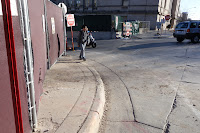Construction along the shore of Lake Mendota--at the Memorial Union--have not been properly inspected for erosion control.
The biggest problem is the required silt curtain, floating in the lake. Its problems are so obvious--that I wonder if anyone has been inspecting the erosion controls.
On November 28, I found four problems...
1. The required silt curtain is non-functional, apparently for some time. Inspecting closeup by boat, I saw...
2. The construction entrances were very dirty, and the street was not being swept. These surfaces drain directly to the lake. Substantial sediment has escaped.
3. The north construction entrance on Park Street, and gravel ramp to the shore, is poorly protected (top photo).
4. This area--where concrete trucks are arriving--appears to have no protection--not even the metal pilings. What is there to prevent concrete washout from getting into the lake?
Lessons from this project
More photos of construction at the Union.
1. The required silt curtain is non-functional, apparently for some time. Inspecting closeup by boat, I saw...
- numerous large gaps in the floats. The curtain hanging below the floats was also ripped in multiple places, and...
- the Styrofoam floats were drifting away and fragmenting. Fragments were found as far as James Madison Park.
2. The construction entrances were very dirty, and the street was not being swept. These surfaces drain directly to the lake. Substantial sediment has escaped.
4. This area--where concrete trucks are arriving--appears to have no protection--not even the metal pilings. What is there to prevent concrete washout from getting into the lake?
Lessons from this project
- Reliance on a "silt curtain" is a mistake. Once phosphorus escapes to the lake from this construction, the curtain won't stop it. And as you can see, the curtain has deteriorated so much that it has become a source of litter.
- The environmental impact statement said "Strict erosion and siltation controls will be practiced during construction to minimize these impacts." But poor execution is proving that study wrong.
- The new tower for the Edgewater Hotel will be built on a steep slope next to the lake (below). Let's hope that project won't rely on a useless silt curtain and non-existent inspection.
More photos of construction at the Union.
 Boldt Construction & Terra Engineering are the contractors
Boldt Construction & Terra Engineering are the contractors













No comments:
Post a Comment
Please feel free to comment on the article above, or on other watershed issues.